
The nutmeg, also known as the clover cutworm, is a moth of the family Noctuidae.

Agrotis is a genus of moths of the family Noctuidae. The genus was erected by Ferdinand Ochsenheimer in 1816. A number of the species of this genus are extinct.

Caradrina morpheus, the mottled rustic, is a moth of the superfamily Noctuoidea. The species was first described by Johann Siegfried Hufnagel in 1766. It is found across the Palearctic from northern Europe to Siberia, Amur and Korea. Also in Armenia and Turkestan. It was accidentally introduced on both the east and west coasts of Canada and is so far reported in the east from New Brunswick to Ontario, and in the west from British Columbia.

Caradrina clavipalpis, the pale mottled willow, is a moth of the family Noctuidae. The species was first described by Giovanni Antonio Scopoli in his 1763 Entomologia Carniolica. It is found in the Palearctic realm. It is an introduced species in North America, where it was first reported from Queens in New York City in 1993. In 2009 it was found in Rochester, New York, so it appears to be established and spreading.

Caradrina kadenii, or Clancy's rustic, is a moth of the family Noctuidae. The species was first described by Christian Friedrich Freyer in 1836. It originates from southern and central Europe, Asia Minor and southern Russia but in the 21st century it has extended its range to the north.
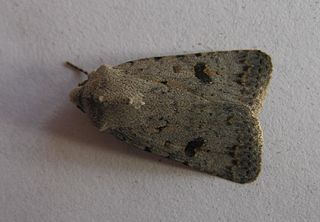
Paradrina rebeli is a moth of the family Noctuidae. The species was first described by Otto Staudinger in 1901. It is endemic to the Canary Islands. Some authors consider the genus Paradrina to be a subgenus of Caradrina, hence the species is also known as Caradrina rebeli or Caradrina (Paradrina) rebeli.
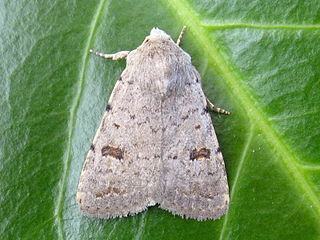
Caradrina is a genus of moths of the family Noctuidae, erected by Ferdinand Ochsenheimer in 1816 and divided into eight subgenera. These include Paradrina and Platyperigea, which some authors treat as separate genera. By 1989, it comprised 189 described species.

Zanclognatha is a genus of litter moths of the family Erebidae. The genus was erected by Julius Lederer in 1857.
Caradrina meralis, the rare sand Quaker, is a moth of the family Noctuidae. The species was first described by Herbert Knowles Morrison in 1875. It is found in North America from New Jersey and New Hampshire, Ontario, Ohio and Wisconsin west across southern Canada to British Columbia, south to California and Arizona.
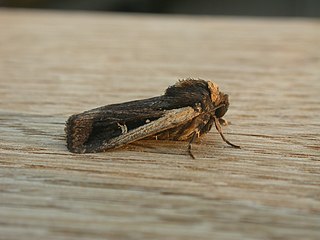
Proteuxoa tortisigna, the streaked rictonis moth or pale-banded noctuid, is a moth of the family Noctuidae. The species was first described by Francis Walker in 1857. It is found in the Australian Capital Territory, New South Wales, Queensland, Tasmania and Victoria
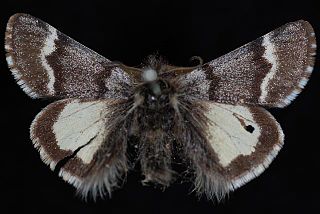
Leucobrephos brephoides, the scarce infant moth, is a moth of the family Geometridae. The species was first described by Francis Walker in 1857. It is found in North America from Yukon to Labrador and south to New York and southern Alberta and British Columbia.
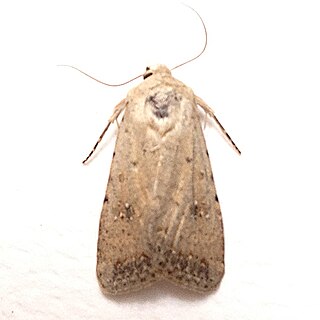
Caradrina montana is a small moth of the family Noctuoidea. It is common to western North America as well as western Asia and Europe. It feeds on alfalfa leaves.
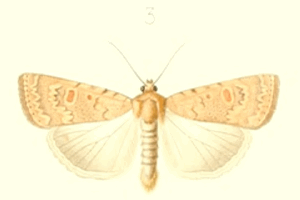
Caradrina flava is a moth of the family Noctuidae. It was described by Charles Oberthür in 1876. It can be found in Spain, Greece, Malta and the Canary Islands, as well as from the Sahara to the Arabian Peninsula, Israel, Jordan, the Levant, Iran and Iraq.

Caradrina selini is a moth of the family Noctuidae. It was described by Jean Baptiste Boisduval in 1840. It is found in most of Europe, North Africa and the Near East.
Caradrina camina is a species of cutworm or dart moth in the family Noctuidae. It is found in North America.

Maceda mansueta is a moth of the family Nolidae first described by Francis Walker in 1857. It is found in Japan, Sri Lanka, Borneo, India (Andamans), Malaysia, New Guinea, Fiji, Australia, Réunion and the Seychelles.














